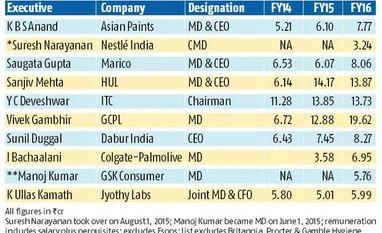The 48-year-old executive, who took over as MD of GCPL in July 2013, was ahead of Hindustan Unilever MD and Chief Executive Officer Sanjiv Mehta and ITC Chairman Y C Deveshwar for the period under review.
In 2014-15, Mehta was the highest-paid FMCG CEO with a remuneration of Rs 14.17 crore. Deveshwar followed next at Rs 13.85 crore, while Gambhir’s pay package was Rs 12.88 crore. Remuneration includes salary plus perquisites but excludes Esops.
In FY16, however, Gambhir topped the list, thanks to a 52 per cent jump in remuneration, while Mehta and Deveshwar took a pay cut of 2.11 per cent and 0.86 per cent, respectively. The other top executives in the top-five bracket include Sunil Duggal of Dabur and Saugata Gupta of Marico.
Duggal’s FY16 remuneration was Rs 8.27 crore, a jump of 11 per cent, while Gupta’s remuneration hike was sharper at 33 per cent for the period under review.
The pay cut for Mehta and Deveshwar in particular came at a time when the companies led by the two struggled to maintain volume growth in a slowing market.
HUL reported its lowest volume growth in five quarters for the three months ended March 2016, at four per cent. ITC, on the other hand, saw flattish growth of one to two per cent in the March 2016 quarter in cigarette volumes. This came after a sustained decline in cigarettes volumes for the previous three quarters of FY16.
Soaps or personal wash, GCPL’s second-largest category, while degrowing six per cent in the March 2016 quarter, held on to growth levels in the previous three quarters of the year. The category, which gives GCPL 35 per cent of its revenue, saw its sharpest growth in the June quarter at 13 per cent, three per cent in the September quarter and two per cent in the December quarter.
Hair colour, in contrast, recovered in the March 2016 quarter with a growth of seven per cent after seeing a decline of 1.1 per cent in the December quarter. For the September and June 2015 quarters, hair colour growth was 17 per cent and 12 per cent, respectively. GCPL, for the record, derives 45 per cent of its revenue from household insecticides and 20 per cent from hair colour.
)